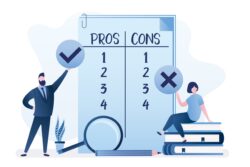No one wants a marriage to end in divorce, but sometimes it’s inevitable, even after trying everything to salvage the relationship. Once you’ve decided that divorce is the best or only option for you, now the hard work begins. Divorce can be an overwhelming prospect – how and where do you start the process?
Often, the first step is to file for the divorce. However, some experts recommend completing some basic preparation and planning prior to officially filing for divorce.
Step 1: Prepare before you file
“In my opinion, the divorce process starts before any paperwork has been filed with the courts,” said Cathy Meyer, a divorce expert and certified divorce coach at EmpoweredDivorcee.com. “Once you’ve made the decision to divorce, you should immediately start taking care of things you can do at home,” in preparation for your divorce, and post-divorce life. This includes “things such as getting bank account statements together, credit account statements, and all pertinent financial and personal information that will pertain to your divorce,” Meyer added.
Being proactive and getting prepared before filing will make the legal process of divorce run more smoothly and will be easier to navigate for you, she explained. “Divorce is a lot about paperwork; you file paperwork at the beginning of the process, during discovery, and with interrogatories…. Staying ahead of the ‘paper chase’ is something you’ll be glad you did.”
If you and your soon-to-be ex-spouse are getting along well enough to collaborate, “work out the division of property and child custody (if applicable) yourselves. It makes litigation much less expensive, as these are the main things that divorcing parties will dispute,” advised Jessica Swords Burton, Esq., of Bernard & Johnson, LLC law office in Atlanta, Georgia.
Additionally, if you plan to hire an attorney for your divorce, you’ll want to retain the firm before filing also, if possible.
Finally, before you file, you may want to do one last gut check, as divorce is a big step, and a costly one. “The most important thing you should do before the legal process starts is to be absolutely sure that it is a divorce you want,” Meyer advised. If you haven’t already, “seek therapy and advice from friends and family when making this decision. Leave no stone unturned when it comes to the reality of divorce, your emotional state, and whether there are solutions to the problems in your marriage that you haven’t considered.”
Step 2: File for divorce
How you proceed with this important step of filing for divorce may vary by state and will depend upon whether you plan to file with legal representation, or without an attorney.
It’s important to research and understand the family and divorce laws in your state, especially if you are representing yourself.
“If you’re a pro se litigant (representing yourself), you have some homework to do!” said Meyer. “Most jurisdictions now offer classes for pro se litigants where they outline exactly how to file your paperwork and a step-by-step explanation of the divorce process in your jurisdiction.”
The most important thing you should do before the legal process starts is to be absolutely sure that it is a divorce you want.
Cathy Meyer, a divorce expert
“Initiating a divorce requires filing a complaint, which is generally in the superior court of the county in which the marital residence is. The complaint should also be verified under oath, which is best to be signed before a notary. Attached to the complaint should be a financial affidavit, proposed divorce agreement, proposed child custody agreement, and a child support calculator (if applicable),” advised Burton, regarding the process in Georgia.
“Should you decide to proceed with your divorce pro se (without an attorney), then [we] recommend doing as much research on the documents you need as possible,” Burton, along with one of her partners who handles family law cases, Alex Johnson, advised. “Some counties [in Georgia] provide templates of the required forms to assist pro se litigants with this process. In any case, you should thoroughly research the law, and most county courthouses have public law libraries where you have access to law books and research databases to begin the research process.” Please note: Some states require an extended period of legal separation of up to one year, prior to divorcing, which may impact the timing and order of events in your divorce process.
Step 3: Serve your spouse
The next step is to formally notify your spouse of your intent to divorce, which is called “serving” the divorce papers. “Once your complaint and paperwork are filed, then you must serve your spouse with the divorce papers. Your spouse will then have 30 days to respond to the complaint,” said Burton.
Step 4: Temporary hearing (if applicable)
Depending upon the laws in your state, and the circumstances of the divorce, a temporary hearing may be scheduled for some immediate and provisional orders and direction regarding custody, spousal support, living arrangements, etc. until these details can be worked out permanently for the long-term, according to Meyer.
Step 5: Discovery and mediation (or court)
“After the temporary hearing, the discovery process will begin,” Meyer explained. “During the discovery process, each party to the divorce can ask questions of the other party. These are written questions such as proof of income and proof of anything you feel is pertinent to your case.” Once the discovery phase is complete, “then you’ll be scheduled for mediation. Mediation is for negotiating your final divorce settlement, and once that is taken care of, the judge will sign the agreement you and your ex-spouse decided upon,” Meyer said. (Some states and divorce circumstances may require any contested issues to be disputed and settled in court.) This is where divorce can become very expensive, and why it’s best for the divorcing parties to work out as much of the divorce details as they can on their own, or in mediation, without lawyers, legal fees, and court fees heavily involved.
Step 6: Finalization and the divorce decree – You’re Divorced!
Once that is complete, and the judge signs off on everything, “you’ll then be [officially] divorced,” according to the divorce guidelines in your state.
Although you’re considered divorced at this point, you may not receive your actual divorce decree for a few weeks, depending on the regulations and waiting period required in your state. Depending upon the circumstances of your divorce, you may even feel like celebrating at this point — in fact, “divorce parties” are becoming increasingly common!
Tips for the smoothest experience possible
Both Burton and Meyer offered a few important tips for getting through all steps of the divorce as smoothly as possible:
- Research and learn the laws and regulations in your state, as well as your rights as they pertain to marriage and divorce.
- For best results, hire a professional who can navigate the legal process and advocate for your best interests, if possible, and if it’s financially feasible for you.
- Make sure you have a support system in place throughout the stressful process of divorce.
- Take advantage of any divorce-related resources and support offered by your jurisdiction or community, if applicable.
Divorce is an area of law in which “a lot of issues may arise in an already emotionally charged process. This is true regardless of the state in which you live, and whatever the dynamics of your marriage (and soon to be divorce) will be,” concluded Burton. Therefore, planning, preparation, support, and professional assistance can be critical to the outcome and results of your divorce.






